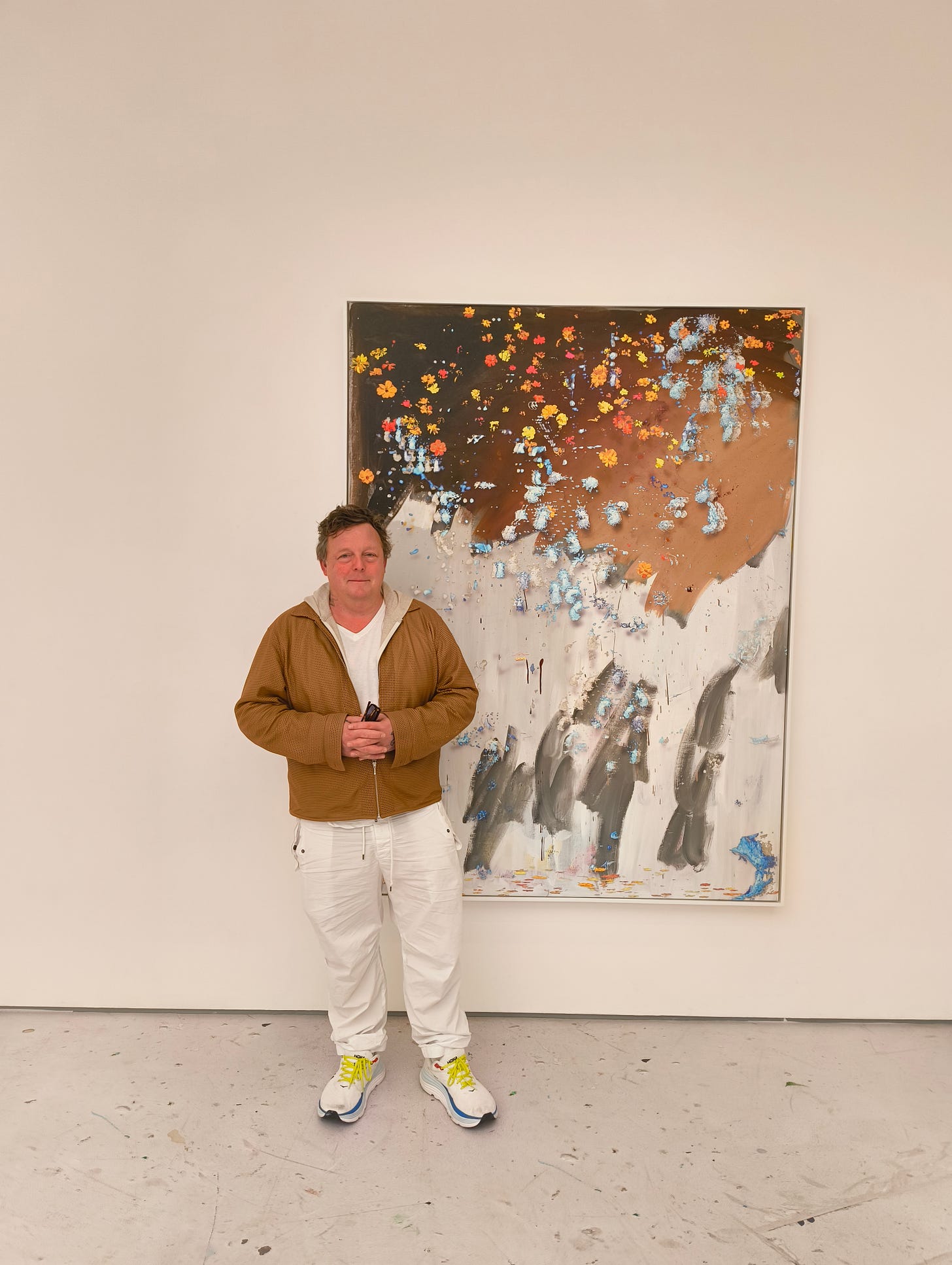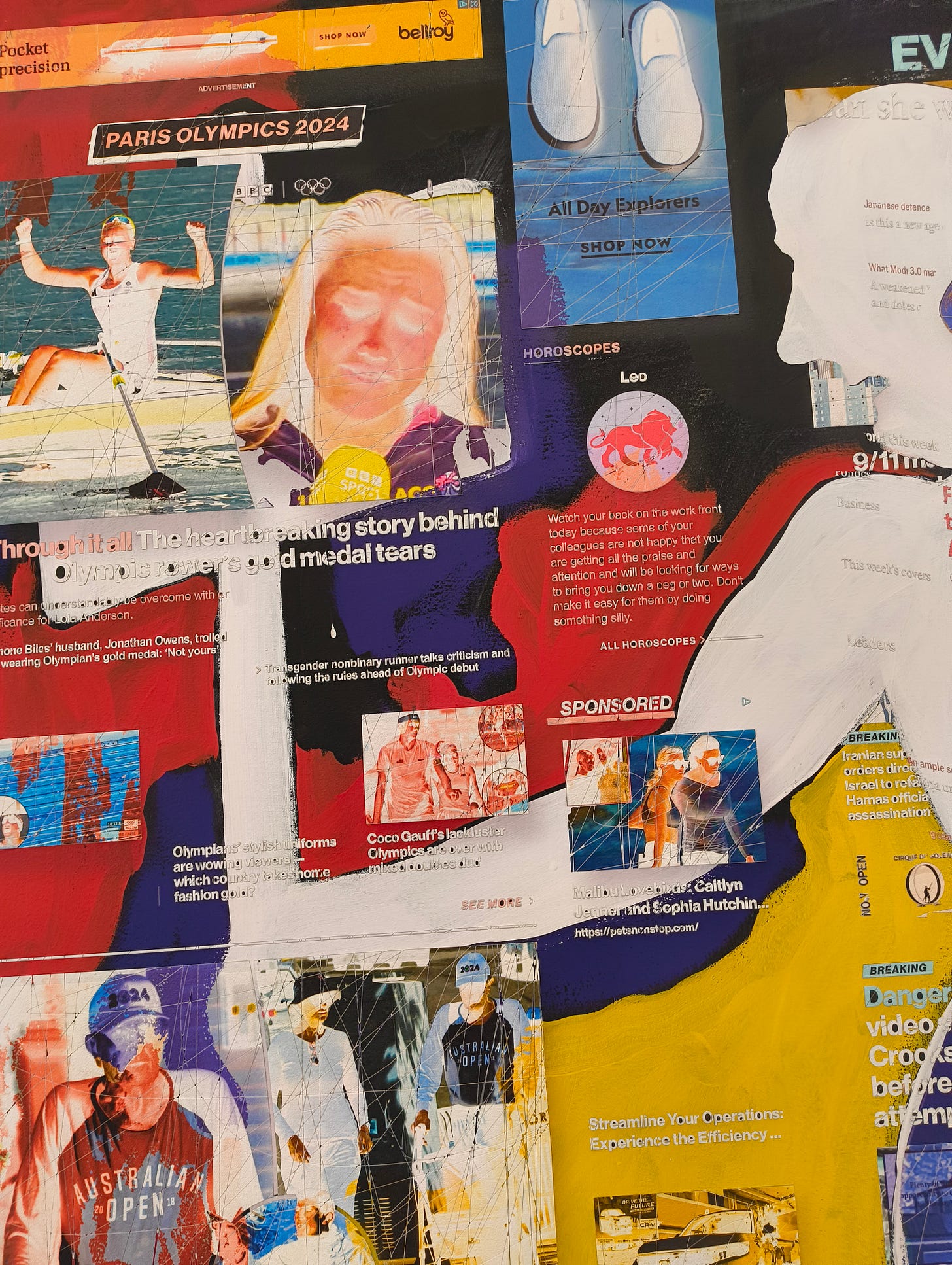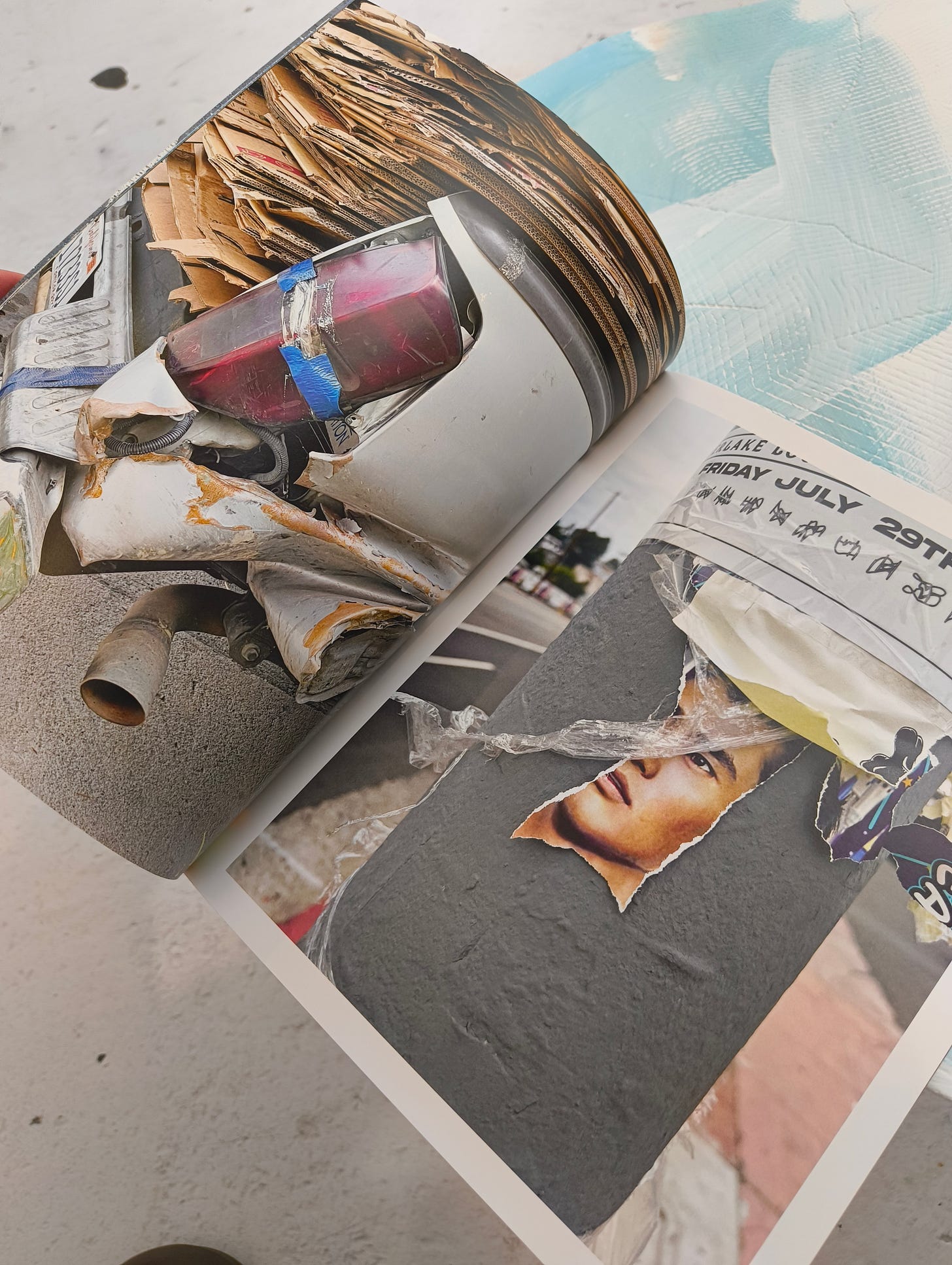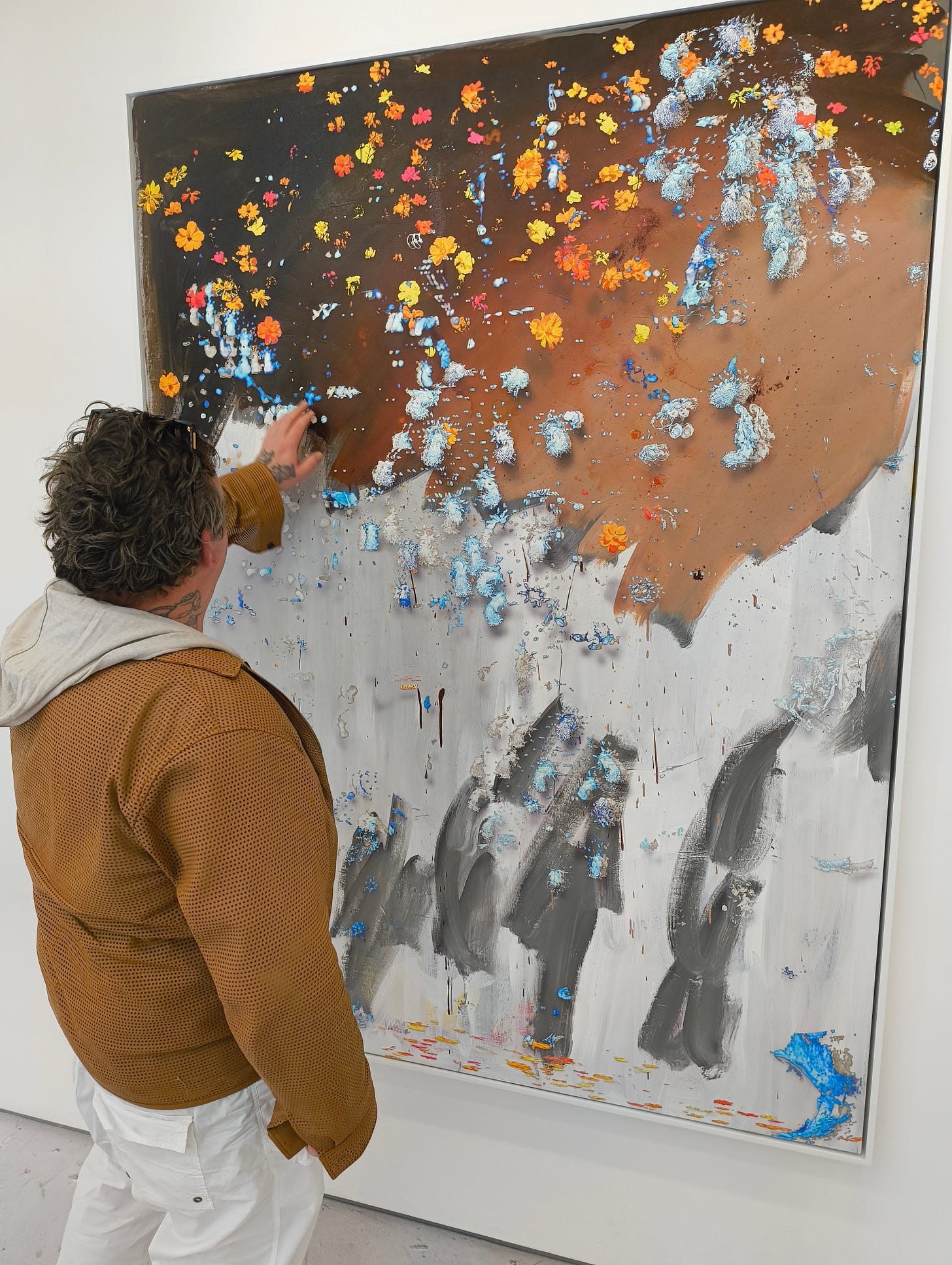I sat down with Urs Fischer on one of the sofas in the gallery space at Sadie Coles on Kingly Street in Soho. It was the day his show opened, and there was a delicate, frisky buzz to the building as the photographer shot the install images and other people tapped away on computers.
Sadie kindly came out to us with a metal tray holding two small bottles of San Pellegrino and three glasses, so I poured water for all of us. But I offered it to her and she said no and slipped away. At this point, Urs was already in full flow in fascinating detail about his paintings and his new book (also called ‘Scratch & Sniff’), and so with a bit of editing for clarity and brevity, this is what he had to say.
JT - We’re on these sofas and you were just explaining that you like the opportunity to sit with the work?
UF - Yeah. I mean, it's kind of your body. If you walk in a gallery and you have to keep standing and moving, you don't spend as much time with the work. On the other hand, when you're in the studio and you make a work, you sit. But usually when something is done in the studio, me and then whoever helps me, we sit there and we just look and then we let it slowly do its thing, particularly these works. They're a little more complex. They're not just “oh, yeah, I get it”, because it's multi-layered. So it’s nice to just spend time and be with the work. I know galleries don't particularly like that because people will just sit here the whole day.
Equally, moving around them is really important to the works because of the layering. From a distance you can't see this kind of impasto effect that you've created on them, and it's by getting up close to them that you experience that.
Exactly. I mean, yeah, you can't unless your eyes are really good, But mine are not anymore. I mean they're kind of animated. And if you stand still, I think the animation of them works better.
You've used a printing technique to build up the layers.
For all of these, the composition is actually on canvas. The composition is not on the computer or on a small format and then scaled up. So the original composition is all painting on canvas, and the printing is actually the thing that happens last. There’s overpainting and we run it through the printer like 15 times. I make a three dimensional map basically. It's like a topography.
So you build up a three dimensional texture rather than an image, which becomes like an impasto. What's underneath?
I thought it's interesting to use figures. I usually don't paint figures. They come out of these paintings I made that were based on my visual experience of living in Los Angeles, which is also what this book is about, but this book is not aimed at being ‘good photography’. It's just some form of record keeping in a really sloppy, post Eugène Atget way of recording a city and not necessarily the people in it… Like with Atget it's all a relic of the people that inhabited the politic or whatever, you know. So in that way it comes out of that. I used to start with an image, or there was some kind of painting, but it was kind of vague or undefined, more like it was taken out of urban compositions where there is whatever, like you have a wall and it's already kind of some form of visual surface and then out of this, I started to bring in some kinds of figures.
So there’s this collage of multiple elements there and then for instance there's a tiny little doodle that says something like “Beautiful Love”.
Yeah, that was all in that space. These drawings were on the wall and then in the back, you kind of see a photo of this abandoned space. If you look left and right on the bottom, you see some kind of space and some trash on the floor. For that I used the underpainting somewhat as the first stencil, and I knocked out a photograph of the canvas that I painted. And then I might distort the images and the shapes, then the printing comes after.
The last time we spoke, it was 2017. Trump was relatively newly in office and you were living in New York and we were in this moment where the concept of ‘truth’ seemed to be very important and very shifting. And you were asking people to literally remodel Rodin’s ‘The Kiss’. And it seems like in the intervening seven years, a lot has happened and a lot keeps happening, and this work feels like an expression of that overload.
In a way, it's a feeling of ‘everything is up’, even nature or somehow, or like how you see everything or images. That's why some of the works have urban things like stuff I found on the street like the cactus or flowers that I found on the side of the road. And some are online experiences, like this one is The Guardian for example. That's just one of the things I look at. There is an Amazon situation over there. So, you just click through all different categories of Amazon, and just cut stuff out. Other ones are political books, just whatever comes as a suggestion. So it's not so literal. And this other one is the New York Post, which I don’t really look at much, but I do like tabloids.
What draws you to tabloids?
They’re better storytellers. You know, my grandfather always had a serious newspaper and a tabloid in the morning with his coffee and croissant. There was even a thing in Switzerland, because maybe for some businessmen it was a little frowned upon (to buy a tabloid), but you could order whatever the fancy newspaper is and they’d insert the tabloid in it for you.
There have been so many arguments in the last 20 years that all the mainstream broadsheet newspapers became more like tabloids anyway, and that already they did that thing of essentially sticking a tabloid within the covers.
Yeah, I'm sure. Also, after 9/11, when the whole thing moved online very quickly when people couldn't wait till next morning to read more about whatever had happened. I remember how fast that shift was to online news and then you wanna see it all the time, and be updated during the day. You don't want to wait until the next day.
I was 13 when 9/11 happened. And it seems that for every major event that's happened in my life since, there has been this desire or this addiction to new information about it.
Yes immediately. You cannot wait until the next day. There is no time that passes to reflect upon what happens. So it's always like the immediate, which is funny because my dad never really read the newspapers. They never had a newspaper delivered to the house. But sometimes whatever old newspaper you gave him, he started reading. We had a whole stack of them in the house, it was just any kind of newspaper. You go look and just start to read some old news, which is always fascinating even now. I mean, some of these (works in the show) are two months old or whatever a month old – some of these are already so irrelevant.
That's what's fascinating about your work. You always seem to operate really in the moment, like you made these works this summer. It's talking about the Paris Olympics. You're not looking back, it's all very immediate.
Yeah, I didn’t choose what’s on there, it's just what's in your way… I do not go and look for a streetlamp, it just looks cool. The same with the online experience, because it's also in your way. The city and the online visual experience are juxtaposed or put next to each other. And in that way the figure is kind of a protagonist. In this way, you could say it is basically me.
It's kind of also like humanising or offering a perspective on all this kind of visual informational detritus that is thrown at us?
I mean, whatever it is, nobody really knows. It's just always there. Like the amount of images we come in contact with. You know, everybody has been talking about this for a long time, but if you think about the amount of imagery being blasted at you, it's a very recent thing. I mean, the oldest images to travel were coins. The coins were the first distribution system of an image or a written thing. Then it becomes an idealised image, and that gets spread out, and that lasts, and we still do that. And then later you have prints of a drawing or of a painting or of a building or whatever. Maybe you have an etching or something that was then distributed. Then logically, wherever that goes after it starts to vastly accelerate. And once you have put the images in a sequence, that leads to a movie. These are all basically images in a sequence and it speeds up. And now that there's so much imagery, which is interesting as an image making person, to think how you insert your image, how you create reality with your images that you can resonate with it long enough that it actually becomes something, but it just doesn't fold right away back into this infinite stream of images, which is kind of crazy. Now I’m playing a lot with this AI stuff. Not a lot, but it's kind of fun.
I saw a reference where someone was talking about ‘Habsburg AI’, like it's becoming degenerate as it generates, inbred, because the more AI information that gets pumped out there, the more the AI then feeds off that on itself. And the more it becomes kind of junkier, like code going wrong. And your work is kind of about making sense of the chaos, even if the outcome looks chaotic.
Yeah, maybe. That’s where you can bring in your human ‘thing’. I don’t really have an opinion. Well I have opinions, but they’re confused and opposing and they’re definitely not to share.
I like the fact that here as well you've brought the floor of your studio.
It’s the studio floor in LA, which is painted white. And that's kind of the idea of sitting on the floor, rather than your physical stroll through the space.
And it invites you to look at the floor as well, which not many galleries do.
The gallery space is always a bit like that. It can be like the people in a kabuki that don't want to be seen. But they're seen, you know, like the white walls and the neat floor that looks kind of perfect… I mean, more and more studios of artists that do well start to look like galleries or something, you know. It's just like products being made in places that look like galleries, that then go in homes that look like galleries. I’m just really bored of it.
Can we talk about the publication? Is it the first time that you've done something with smell?
Yeah, I mean, in a publication, yes. I wanted to do the scratch and sniff on the covers but it’s not possible. The covers have a foil stamp so they're really colourful things underneath. So everybody can make their own little composition, you know? And these photos are just markings on the city, you know, just people leaving things, leaving notes, leaving messages. And this is just like when you're looking out of a car, the whole visuality of that city doesn’t stand still, you know, people spray graffiti then they wipe them out. And that is all done with speed.
So it's interesting because the city kind of does its own version of what your work does here, right? It does this layering, like the palimpsests of the words written over the words.
That's why there are not many people in the book. This is this graffiti that I used there in the middle painting, “going insane”. It's kinda good. And you know, funnily enough, everything is kind of scuffed and marked wherever you look and you never see people on the street that actually leave the marking and stuffing.
Isn't it amazing with LA, how it's so full of money and glamour, and yet so much of the physical construction of the city seems so kind of rickety. You're at the Gucci store and you look up and it's like a shed.
Yeah, I mean, most of it's built in the last 100 years. It's still like a bit of a settler thing because it's not old. People just built something. Like my house is from 1920 and I don’t think they thought that would be there 100 years later.
And what took you to LA?
I had different reasons. My first reason was being a teenager growing up in a mediaeval city in Zurich, and you just kind of wanna get out of that. And then the idea was always like the fantasy of LA, at the western edge of the Western culture. It's where it kind of ends and comes to a stop at the Pacific… And also the shallow entertainment stuff was really frowned upon, so I kind of I really like it.
It's kind of the anti-Zurich, isn't it?
It's kind of the anti-Zurich, but it's also not. I don't go to operas, but I do think a good blockbuster movie is basically like an opera. You fire on all cylinders in every department, and then you do the maximum – singing, composition, the orchestra, the costumes, the house where it's played into the stage… So in that way, I like LA as my idea of entertainment. Not in some kind of, like highbrow-lowbrow conversation, just more I felt it as a freeing idea. So I went there in the nineties at first, but I didn't really know what to do there at that point. It was far away and I had other things to do, and I got stuck in New York. And now my kids like it there and we kind of moved back and it's nice.
I always feel when I’m there that I’m also kind of on the edge of the world with the time zone. The rest of the world's day has finished before Asia starts again, so you're in this kind of dream-like space.
I like having space. I also like the unfinishedness. I come from a place where every square centimetre is cultivated or accounted for or regulated… I mean LA county is 10 million people, that's more than the inhabitants of Switzerland. It's too big to civilise in the way that I was taught ‘civilising’ a place is. There's no economic reality of keeping it neat.
So one last thing on this show here, they're big works.
I always made paintings that are large. It makes sense to me, I like art that has a little bit of space. The problem is the world cannot really absorb that much large work. Beyond galleries, museums, institutions, outside of that, there’s not that much room for works that are larger… But I don’t care. You cannot always think along these lines.
You’ve kind of got to make the work that needs to be made?
Yeah, this, but also like, it depends on how far away you look at something. I like sitting in here and seeing things from afar, and you can because it's larger. So it's not, like, right up against your face. And in that way, it works, you know.
As I said before, it's really nice being up close with them too, because you have this textural element to them and you can read so many of the things that are written, the small little scribbles and details.
Yeah, it's fun, I had fun doing it. I don't know what it is. You know what I mean? Even compositionally it's kind of all over the place and stuff. There's no linear approach.
Thanks
62 Kingly Street W1
The show runs until 26 October.





